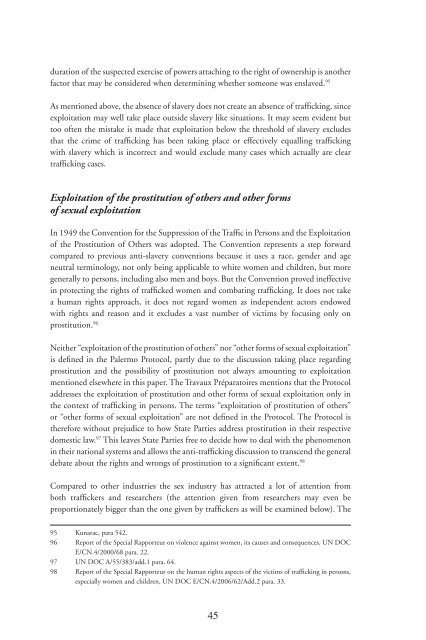Trafficking in human beings: human rights and ... - unesdoc - Unesco
Trafficking in human beings: human rights and ... - unesdoc - Unesco
Trafficking in human beings: human rights and ... - unesdoc - Unesco
You also want an ePaper? Increase the reach of your titles
YUMPU automatically turns print PDFs into web optimized ePapers that Google loves.
duration of the suspected exercise of powers attach<strong>in</strong>g to the right of ownership is another<br />
factor that may be considered when determ<strong>in</strong><strong>in</strong>g whether someone was enslaved. 95<br />
As mentioned above, the absence of slavery does not create an absence of traffi ck<strong>in</strong>g, s<strong>in</strong>ce<br />
exploitation may well take place outside slavery like situations. It may seem evident but<br />
too often the mistake is made that exploitation below the threshold of slavery excludes<br />
that the crime of traffi ck<strong>in</strong>g has been tak<strong>in</strong>g place or effectively equall<strong>in</strong>g traffi ck<strong>in</strong>g<br />
with slavery which is <strong>in</strong>correct <strong>and</strong> would exclude many cases which actually are clear<br />
traffi ck<strong>in</strong>g cases.<br />
Exploitation of the prostitution of others <strong>and</strong> other forms<br />
of sexual exploitation<br />
In 1949 the Convention for the Suppression of the Traffi c <strong>in</strong> Persons <strong>and</strong> the Exploitation<br />
of the Prostitution of Others was adopted. The Convention represents a step forward<br />
compared to previous anti-slavery conventions because it uses a race, gender <strong>and</strong> age<br />
neutral term<strong>in</strong>ology, not only be<strong>in</strong>g applicable to white women <strong>and</strong> children, but more<br />
generally to persons, <strong>in</strong>clud<strong>in</strong>g also men <strong>and</strong> boys. But the Convention proved <strong>in</strong>effective<br />
<strong>in</strong> protect<strong>in</strong>g the <strong>rights</strong> of traffi cked women <strong>and</strong> combat<strong>in</strong>g traffi ck<strong>in</strong>g. It does not take<br />
a <strong>human</strong> <strong>rights</strong> approach, it does not regard women as <strong>in</strong>dependent actors endowed<br />
with <strong>rights</strong> <strong>and</strong> reason <strong>and</strong> it excludes a vast number of victims by focus<strong>in</strong>g only on<br />
prostitution. 96<br />
Neither “exploitation of the prostitution of others” nor “other forms of sexual exploitation”<br />
is defi ned <strong>in</strong> the Palermo Protocol, partly due to the discussion tak<strong>in</strong>g place regard<strong>in</strong>g<br />
prostitution <strong>and</strong> the possibility of prostitution not always amount<strong>in</strong>g to exploitation<br />
mentioned elsewhere <strong>in</strong> this paper. The Travaux Préparatoires mentions that the Protocol<br />
addresses the exploitation of prostitution <strong>and</strong> other forms of sexual exploitation only <strong>in</strong><br />
the context of traffi ck<strong>in</strong>g <strong>in</strong> persons. The terms “exploitation of prostitution of others”<br />
or “other forms of sexual exploitation” are not defi ned <strong>in</strong> the Protocol. The Protocol is<br />
therefore without prejudice to how State Parties address prostitution <strong>in</strong> their respective<br />
domestic law. 97 This leaves State Parties free to decide how to deal with the phenomenon<br />
<strong>in</strong> their national systems <strong>and</strong> allows the anti-traffi ck<strong>in</strong>g discussion to transcend the general<br />
debate about the <strong>rights</strong> <strong>and</strong> wrongs of prostitution to a signifi cant extent. 98<br />
Compared to other <strong>in</strong>dustries the sex <strong>in</strong>dustry has attracted a lot of attention from<br />
both traffi ckers <strong>and</strong> researchers (the attention given from researchers may even be<br />
proportionately bigger than the one given by traffi ckers as will be exam<strong>in</strong>ed below). The<br />
95 Kunarac, para 542.<br />
96 Report of the Special Rapporteur on violence aga<strong>in</strong>st women, its causes <strong>and</strong> consequences. UN DOC<br />
E/CN.4/2000/68 para. 22.<br />
97 UN DOC A/55/383/add.1 para. 64.<br />
98 Report of the Special Rapporteur on the <strong>human</strong> <strong>rights</strong> aspects of the victims of traffi ck<strong>in</strong>g <strong>in</strong> persons,<br />
especially women <strong>and</strong> children, UN DOC E/CN.4/2006/62/Add.2 para. 33.<br />
45

















